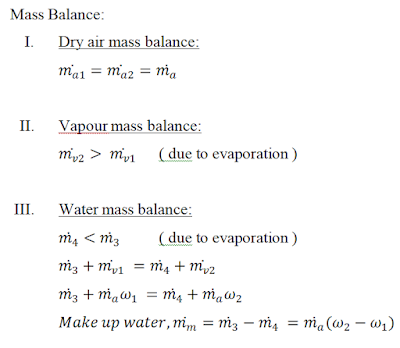Cooling Tower Demonstration System
Cooling Tower Demonstration System
Figure 1: Cooling Tower Demonstration System
No
|
Component
|
1
|
Orifice
|
2
|
Water
Distributor
|
3
|
Temperature
Indicator
|
4
|
Make-up
tank
|
5
|
Heater
|
6
|
Inclined
Manometer
|
7
|
Valves
|
8
|
Receiver
Tank
|
9
|
Blower
|
10
|
Temperature
Sensor
|
INTRODUCTION
AND THEORY:
Cooling tower function is used to
cool down hot water by removing the heat. The heat of the water is mainly
removed by evaporation process. Besides that, water also cooled down by
radiation, conduction, convection. However, the effect of cooling is not
significant compared to evaporation.
Figure 2: Schematic Diagram of Mass flow for cooling Tower
Cooling tower is widely used in industry and it main
function is removing excessive unwanted heat from high temperature water. Heat
from hot water is removed by evaporation process. However, water also cooled
down by radiation, conduction, convection. However, the effect of cooling is
not significant compared to evaporation.
In the evaporation process, small portion of water was
evaporated, thus the exiting air has higher humidity ratio and the water leave
the tower in the form of vapour. With the assumption of the dry air and water
vapour are ideal gasses, the mass of water evaporated can be determined. The
mass of water evaporated should be equal to mass of water losses in make-up
tank.
There are a few applications that are similar to the cooling
tower demonstration system such as closed-cycle wet cooling tower, closed-cycle
dry cooling tower and open-cycle cooling tower. In a closed-cycle wet cooling
system, the heat from the turbine is absorbed by a small portion of water, some
of the water released from the cooling tower as vapour and the rest being
resaved and recirculated in next cycle. The wet cooling system consumes
approximately 97% less water than the one-pass cooling system. This reduction
in the amount of water greatly reduces the number of organisms that have been
killed during ingestion.
Closed-loop circulating dry cooling tower is another
alternative that uses much less water than once through cooling, with less
environmental impact. In areas with scarce water resources, the dry cooling
system more common used because the dry cooling system required less water and
it has high energy efficiency. This system use a small amount of water and
water can be resaved and recirculated in next cycle. Therefore, the dry cooling
system solves the problem for continuous access to cooling water and does not
produce the same air quality problems as the closed-cycle wet system. The dry
cooling system also significantly reduces the volume of water discharged into
the environment, but the concentrated wastewater may contain high levels of
contaminants, which causes toxic problems. In addition, the dry cooling system
has a high capital cost and is generally less efficient than a wet cooling
system.
Open-cycle
cooling tower is removing heat from water because of the material and heat
exchange between the water and the ambient air. Warm water is pumped from the
load tank through the control valve and water flow meter to the column cap.
After water enters the tank, it is uniformly distributed over the top packing
deck and spreads over the plates. At the same time a large thin film of water
is exposed to the air stream. Then, the water is quickly cascades down the
column and leaves at the bottom. Through this process the heat exchange process
is occurred where water is cooled. However, the water cannot be cooled down
below the wet bulb temperature.
Packing Density
has linear relationship to efficiency of cooling tower. Packing Density is the
ratio of the surface areas of all levels of the cooling column to the column
volume in the units of m2 /m3. As the packing density of the distributor of
cooling tower increased, the surface area of plates that are exposed to water
increased. Total surface area and packing density of the distributor of cooling
tower can be increased by increasing the number of plates. The efficiency of
cooling tower efficiency increased as the total surface area in distributor
increased. This is due to higher evaporation rate as more water contact with
plates. Thus, more heats are removed. Furthermore, the design for arrangement of plates is important because
good design helps the water flow smoothly and the heat can be released to
environment without being trapped.




Comments
Post a Comment